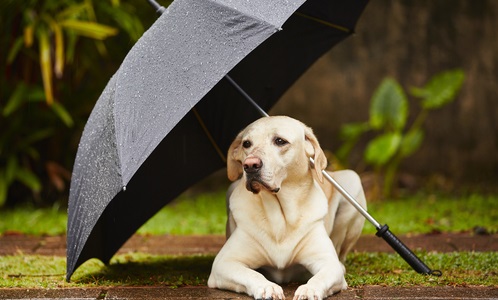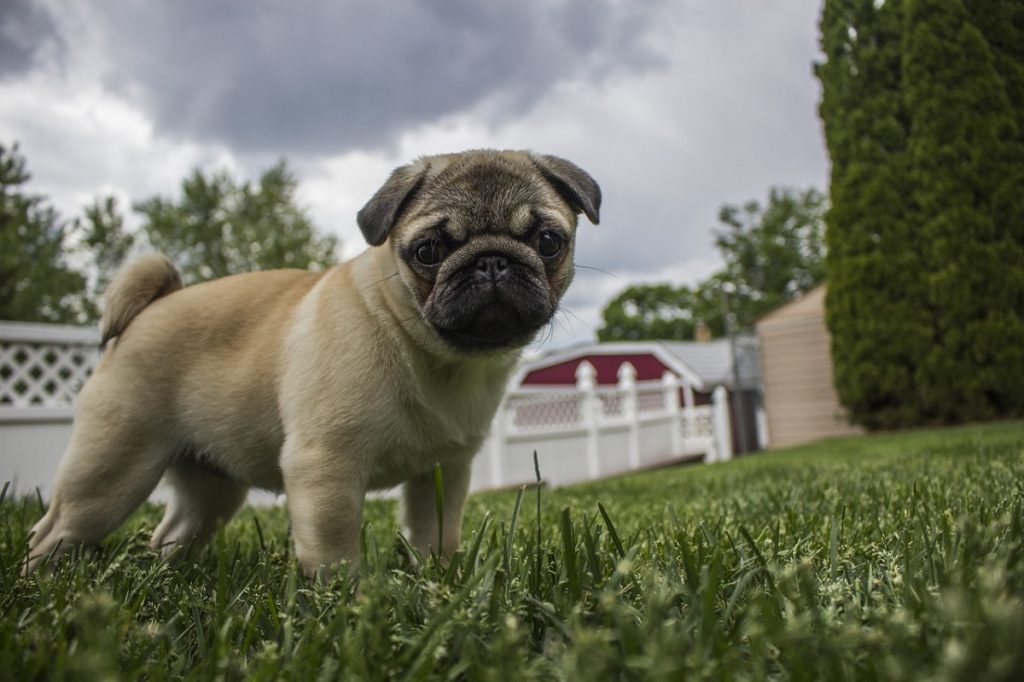Is your dog scared of thunder? While it may seem overly dramatic to some folks, it is in fact a real phobia – and according to experts, should not be taken lightly. Unfortunately, if nothing is done to remediate the behavioral problems associated with a dog’s storm phobia, it will not only continue, but most likely worsen over time. So what’s a pet parent to do when their pooch is crouched in the corner during a massive thunderstorm? Read on for helpful tips and guidelines and learn how to transform fear-stricken pups into confident canines.
Your Dog’s Thunderstorm Phobias: Understanding The Triggers
While dog experts may not know the exact triggers that set a dog’s storm phobias off, research has shown that it’s actually a combination of things, including (of course) thunder, lightning, wind, static electricity, low-frequency sounds following a storm that are inaudible to humans, and even changes in the barometric pressure. Considering all of the variables, it’s literally the ‘perfect storm’ (so to speak) to get an anxious dog worked up! There are even some theories that dogs may experience uncomfortable electric shocks from the static build-up before a thunderstorm. In fact, it is estimated that 15% to 30% of dogs suffer from some form of storm-related anxiety. And while there are some pooches with storm phobias who are also easily scared by other loud noises (such as fireworks), there are others who are only afraid of storms.
Based on various studies, here are some other reasons dogs may develop thunder phobias:
- Breed: According to research by Tufts University, some herding breeds (e.g., Border Collies) may have a genetic predisposition to thunder phobia.
- Behavior: Dogs who display other types of fear-based behaviors (such as separation anxiety) seem more inclined to panic during thunderstorms.
- Gender, Age & History: Studies have also shown that age, sex and acquisition of the dog may also impact the likelihood that a dog will suffer from this condition. Furthermore, it should be noted that female dogs and neutered males are more prone to this phobia, as well as dogs that have been rehomed.
- Personality: Believe it or not, a dog’s personality has been linked to his inclination towards storm phobias. For example, anxious or fearful pups who startle easily and/or lack confidence are more prone to develop a fear of thunder than well-socialized, confident dogs.
- Medical Conditions: For dog parents observing phobic behavior in their pet, it’s important to rule out any possible medical issues – conditions such as canine arthritis, blindness, hypothyroid disease and Addison’s disease can affect a dog’s stress levels and overall behavior.
 No matter what the case, one thing is for certain: if a dog shows anxious behavior during a thunderstorm, chances are these scenarios will only increase throughout the season as the storms become more frequent. Since most dogs won’t outgrow this behavior on their own, it’s crucial for pet parents to help pups acclimate to thunderstorms and break the cycle of phobic behavior.
No matter what the case, one thing is for certain: if a dog shows anxious behavior during a thunderstorm, chances are these scenarios will only increase throughout the season as the storms become more frequent. Since most dogs won’t outgrow this behavior on their own, it’s crucial for pet parents to help pups acclimate to thunderstorms and break the cycle of phobic behavior.
Some general signs that a dog is suffering from thunderstorm phobia may include:
- Pacing incessantly
- Panting, drooling or slobbering
- Shaking and trembling
- Whining or barking
- Hiding
- Becoming clingy
- Scratching or digging at windows or doors
- Chewing on paws or tail; chewing other objects in the home (walls, carpets etc.)
- Urinating and/or defecating indoors
- Visible signs of panic, anxiety or fear
- Destructive or panicked to the point of damaging surroundings and/or injuring himself
If one or more of these symptoms is observed, chances are the dog in question has a phobia of thunder and lightning storms. However, there are a number of different approaches to reduce his stress levels during storm season while providing coping skills so that he can get through a thunderstorm when he’s home alone.
How To Reduce Thunderstorm Anxiety In Canines: Top Ten Tips
Even though pet owners can’t control the weather, they can take a proactive stance when it comes to reducing their pet’s thunder-related anxiety. Below, some useful tips that can help anxious dogs (and their concerned parents) cope with thunderstorms:
Keep him company: Although it might seem fairly obvious, keeping a faithful companion company during a storm will help to ease his mind – after all, he’s already a wreck, so being alone will only heighten his fear. If heavy thunderstorms are in the forecast, try to be home with nervous pups or have a trusted family member or friend stay with the dog during the storm.
Provide a safe space: One of the most direct ways to calm a nervous dog, creating a space where he feels safe can work wonders when it comes to easing anxiety. Because dogs are instinctually pack animals whose ancestors burrowed in the leaves and the dirt, canines have a natural tendency to feel comforted in enclosed places, such as a crate. Be sure to keep the crate open so the dog doesn’t feel claustrophobic or trapped, and fill with his favorite items, such as a stuffed animal or a fuzzy blanket. If his crate is in a room with windows, draw the curtains or blinds so that he can’t see outside. For dogs who prefer to find a quiet spot in the home, be certain to keep doors open in out-of-the-way rooms he might seek respite in, such as a coat closet, garage, bathroom or basement. As long as a dog is safe and isn’t hurting himself, allowing him to ‘hide’ in his favorite cozy spot in the home can help reduce phobia-related fear and anxiety.
Increase his exercise before a storm begins: While it may seem like a fairly simple routine, taking thunder-phobic dogs for a walk before a big storm may actually help – in addition to tiring him out both physically and mentally, some vets have claimed that it will aid in boosting his serotonin levels, which act as a natural calming aid.
Be mindful of your behavior during a thunderstorm: Although it’s an instinctual urge to cuddle or pet dogs when they seemed stressed or anxious, experts advise that consoling a dog every time he gets anxious will only reinforce his nervous behavior, and may actually be interpreted by the animal as a ‘reward’ for his fearful response. On the other hand, punishing or scolding a dog when he’s panicky will only increase his anxiety levels. Therefore, striking a balance is key to successfully modifying this sort of behavior. By projecting a calm and collected demeanor, pet parents set the tone, while engaging a dog in activities he typically enjoys will help ‘normalize’ the situation and take his mind off of the storm. Instinctually herd animals, dogs see their humans as the ‘leader’ – so if the owner is calm, he will usually follow by example.
 Create noise to keep him calm: While storm-phobic dogs may be very sensitive to the loud noises associated with the thunder itself, fur baby parents can actually help keep pups calm by using the TV or a radio on a low volume to draw focus away from the sounds outside. Beyond closing the windows, a white noise approach may be another solution worth considering – try a white-noise machine or simply turn on the air conditioner or a fan. Dog owners may wish to experiment with some of these suggestions until they’ve identified one that the dogs responds to favorably.
Create noise to keep him calm: While storm-phobic dogs may be very sensitive to the loud noises associated with the thunder itself, fur baby parents can actually help keep pups calm by using the TV or a radio on a low volume to draw focus away from the sounds outside. Beyond closing the windows, a white noise approach may be another solution worth considering – try a white-noise machine or simply turn on the air conditioner or a fan. Dog owners may wish to experiment with some of these suggestions until they’ve identified one that the dogs responds to favorably.
Use distraction to take his mind off things: Taking a dog’s focus off the thunderstorm may not be an easy task; however, by engaging pets in activities, pet parents can help take his mind off things inside while a storm is raging outside. Opt for favorite shared activities – such as playing tug-of-war, teaching him tricks, training exercises, or even providing him with a puzzle or food-stuffed chew-toy – to draw his attention away from the thunder. Distracting an anxious dog isn’t much different than how you’d distract a fearful person – by providing a mental activity to hold his attention, it gives the dog less time to focus on the object of their fear.
Create a sense of calm through swaddling: Just as infants are instantly comforted and contented when swaddled, dogs aren’t much different – in fact, body wraps and jackets such as the very commercially-popular Thundershirt are so helpful at calming nervous dogs in a thunderstorm, they’ve become widely recognized by owners and vets alike as a great product to help manage anxious pets. According to experts, these commercially-produced wraps provide a sensation of pressure, which can help alleviate a dog’s thunder-induced panic attacks. However, dog owners can also attempt their own DIY-style version – simply buy a small T-shirt and place the dog’s front legs through the armholes of the shirt. Be sure the shirt fits snugly around the dog’s torso to ensure it has the desired effect.
Explore natural remedies & homeopathy: For folks who prefer to use all-natural treatments for their four-legged friend, there are many different options available – from essential oil blends that invoke a sense of calm and stress relief (either as a room fragrance or ingested orally) to homeopathic remedies and nutritional supplements available online, there are a number of natural anti-anxiety products available for dogs. Pheromone therapy is another technique that has been shown to be a useful treatment for nervous pups, while other pet owners have found success using earmuffs designed especially for dogs who dislike loud noises. As in any form of treatment, always consult a vet before administering any CBD for dogs or other pets.
Consider behavior modification techniques: Although this technique may require a higher level of skill and professional expertise (most experts recommend consulting a certified dog trainer or animal behaviorist), the effects of systematic desensitization have been observed as an effective treatment method for dogs who suffer from extreme thunder phobias. A form of behavior modification, systematic desensitization involves exposing a dog to a frightening stimulus in small amounts – and then reinforcing this negative experience by pairing it with a positive experience, such as a delicious treat or a favorite toy/activity. Because this is merely a summary of this rather complex training technique, it’s important to consult a behavioral training specialist before attempting yourself. An expert will help guide pet parents when it comes to recognizing a dog’s body language, modifying the techniques so it is tailored to the dog’s specific behaviors and disposition, and other key elements required to carry out this advanced form of canine training.
Seek professional assistance: When it comes to disciplining or training one’s dog, there is no shame in asking for professional guidance or help. For dogs who suffer severely from thunder phobias (or canine phobias in general), the level of stress they’re experiencing may require a call in to the experts. Whether reaching out to a trusted veterinarian or receiving the assistance of a licensed dog trainer or behaviorist, dog owners and their beloved pooches can benefit from the expertise only a professional can provide. For additional resources and information for professionals in your area, check out the Animal Behavior Society, the IAABC (International Association Of Animal Behavior Consultants), and the American College of Veterinary Behaviorists.
Sources Cited:
- Bittel, Marybeth. “Is Your Dog Scared of Thunder? 6 Tips for Soothing Him.” dogster.com, June 5, 2018, https://www.dogster.com/lifestyle/6-tips-for-soothing-your-dogs-fear-of-thunder. Accessed May 28, 2019.
- Sashin, Daphne. “When Your Dog Is Afraid of Storms.” Pets.WebMD.com, (no publish date), https://pets.webmd.com/dogs/features/dog-storm-phobia#1. Accessed May 28, 2019.
- Blake, Mychelle, MSW, CDBC, Lifestyle Contributor and Pet Behavior Expert. “My Dog is Scared of Thunder.” Pet Health Network.com, May 16, 2016, http://www.pethealthnetwork.com/dog-health/dog-behavior/my-dog-scared-thunder. Accessed May 28, 2019.




